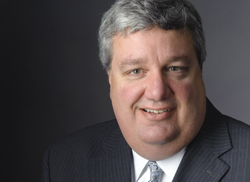Intermountain live with Cerner EHR

Fifteen months after Intermountain Healthcare and Cerner signed a contract that keeps them in partnership for the next 10 years, Intermountain, known around the world for its pioneering ways, is trailblazing again.
Intermountain has two hospitals and 24 clinics live on Cerner technology, and that's just a small fraction of what's in store.
With 350 custom products built to add to the Cerner base application, more than 200 interfaces created and more than 2,200 end users trained, the implementation is a feat that gives Intermountain CIO Marc Probst and Cerner's point man, Jeff Townsend, reason for buoyancy – confidence enough to take the fast track.
"There are a number of us that would like to see this project completed in 2015 – across all our hospitals, all of our clinics," Probst told Healthcare IT News. "We're not ready to announce anything, but we're going to go quickly. It's gone well, and it's going to be one for the record."
Townsend concurred. "We'll go incredibly fast to get everything on the same platform," he said.
[See also: Intermountain signs sweeping EHR deal.]
There are 20 hospitals left to go live and hundreds of clinics scattered across a state known for its mountain ranges, canyons and Great Salt Lake.
 The rollout at Logan Regional and Bear River Valley hospitals and surrounding Intermountain clinics, located about 80 miles northeast of Salt Lake City, was Feb. 21.
The rollout at Logan Regional and Bear River Valley hospitals and surrounding Intermountain clinics, located about 80 miles northeast of Salt Lake City, was Feb. 21.
Slated for go-live, shortly after the 2015 HIMSS Annual Conference and Exhibition in April are the rest of the Intermountain hospitals and clinics in the North Region. Included is Intermountain's second largest hospital, McKay-Dee hospital in Ogden. Also, part of the project is a hospital in southern Idaho that has about 100 clinics spread over a large region.
"That's our next kind of big swing at it to see how we're doing," Probst said. "We're very confident about it, but we'll learn. We'll learn as we take that region live."
Plenty of challenges
There were plenty of challenges leading up to the first go-live. Probst describes them as the type of complications attendant to any implementation: workflow issues that had to be addressed; interfaces that had to be improved quickly; and, of course, some software bugs that had to be quickly changed and put into production.
"But, having been through a number of these implementations, this has gone as quickly as I've seen," Probst said.
"It's gone well, and it's going to be one for the record."
Marc Probst
Cerner and Intermountain have named the integrated EHR, practice management and revenue cycle system, iCentra.
"Everything's integrated," Townsend said, "and that was a pretty big shift across the clinical and business leadership – that the systems being replaced were being replaced with systems that one group turns a dial, the other group feels it."
The handoffs between physicians that are in a clinic setting sending into the hospital, or the hospital sending in and out of surgery – every single handoff had to be designed and worked through, Townsend explained.
And they were.
"It's all sitting there inside the system," Townsend said, noting that it's among the most gratifying pieces of the project for him.
"It's been everyone being able to understand what integration means and what their role is beyond kind of their boundary," he said.
For Probst, those areas – surgery, anesthesiology and the emergency department – had been a regular headache from a CIO point of view.
"We are getting such positive feedback from people in surgery and the anesthesiologists and ED," Probst said. "It's a real pleasure. I think they've worked in a more walled off area, you know. Everything happens within that area. And it really had been these transitions that had been the challenge."
 Agile implementation
Agile implementation
Townsend and Probst have put in place a process they call "agile" implementation. As Townsend describes it, agile implementation is a 4-to-6 week deployment cycle during which the implementation team makes modifications, gets feedback from users, and repeats the back-and-forth until the technology and processes being tested work right for the use.
Open architecture and agile implementation made it possible for the tech team to build in the 350 of the care process models that patient safety and analytics guru Brent James, MD, developed over many years.
"We've been able to build all that in," Probst said. "Now the physicians are going to have a much bigger hand in the changes to the system because they can, the way that this has been built."
James, chief quality officer and executive director of the Institute for Health Care Delivery Research at Intermountain, is known around the world as a longtime champion for standardizing care by employing data collection and analysis. He's sure Intermountain will not stop innovating.
"We looked closely not just at what we presently do – could we somehow kludge across what we presently do – but we had a pretty good sense of what was next," James said when Intermountain announced on its sweeping EHR deal with Cerner on Sept. 30, 2013. "Can it change and adapt to that next world – a better world, frankly – levels of patient care beyond what we do today."
[See also: Intermountain, Deloitte put data to work.]
It seems to Probst that every piece of Intermountain is on board with this massive and disruptive undertaking. He credits the leaders.
"The fact that this was led by our business and by a physician, Dr. Mark Briesacher (Senior Administrative Medical Director, Salt Lake Region) made all the difference – in attitude in how other physicians approached this, to how we were able to engage them early in the process, and go through this agile implementation and understanding," he said.
 "This wasn't an IT project that was sponsored by executives," Townsend added. "It was one that was led by their executives. So business leaders, clinical leaders took ownership of the project from the beginning."
"This wasn't an IT project that was sponsored by executives," Townsend added. "It was one that was led by their executives. So business leaders, clinical leaders took ownership of the project from the beginning."
What's next?
"One of our joint objectives – because this will never be done, but it should be continuous – is we created a methodology that got us through the first one at an incredibly rapid speed that allows us to continue to make change at the pace we made it over the last year before we went live," Townsend said. "So can we continue to roll out to the rest of the regions and improve while we go – at least for me that's the big metric on whether we tapped into the next-generation methodology that allows you to stay current as well as learn, not just at the system level, but at the people, process level.
"Most organizations would turn the first one on, freeze everything for the next year or three years and not make any changes so they could optimize for deployment."
Intermountain Healthcare's iCentra work will be highlighted at HIMSS15 both at the Intermountain Booth 3660, South Hall, and the Cerner Booth 913, South Hall. Intermountain CIO Marc Probst will offer an update at the Cerner media breakfast on Tuesday, April 14.
























